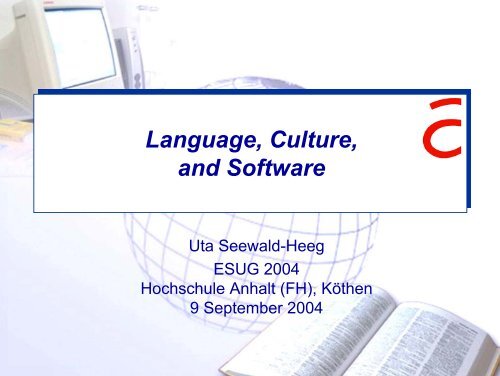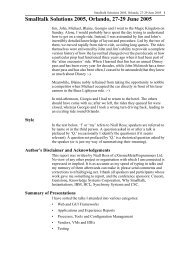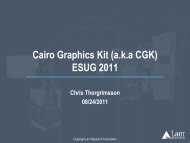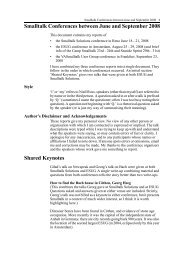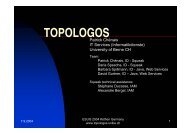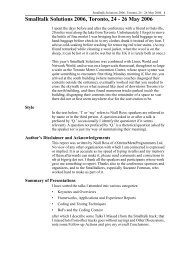Language, Culture, and Software - ESUG
Language, Culture, and Software - ESUG
Language, Culture, and Software - ESUG
Create successful ePaper yourself
Turn your PDF publications into a flip-book with our unique Google optimized e-Paper software.
<strong>Language</strong>, <strong>Culture</strong>,<br />
<strong>and</strong> <strong>Software</strong><br />
Uta Seewald-Heeg<br />
<strong>ESUG</strong> 2004<br />
Hochschule Anhalt (FH), Köthen<br />
9 September 2004
<strong>Language</strong><br />
<br />
tree Baum arbre дерево albero
<strong>Language</strong><br />
after Ferdin<strong>and</strong> de Saussure (1857-1913)<br />
concept<br />
image<br />
acoustique<br />
Baum<br />
signifié<br />
signifiant
<strong>Language</strong><br />
• System of of signs<br />
• By convention
Structural Differences<br />
between <strong>Language</strong>s<br />
dt. Schloss<br />
fr.<br />
château<br />
castle<br />
serrure<br />
lock<br />
Mensch<br />
Mann<br />
Ehemann<br />
homme mari époux
Communication<br />
Knowledge<br />
Medium<br />
Relation<br />
Knowledge<br />
Sender<br />
Message<br />
Channel<br />
Receiver<br />
<strong>Language</strong><br />
Content<br />
<strong>Language</strong><br />
<strong>Culture</strong><br />
<strong>Culture</strong>
<strong>Culture</strong><br />
<strong>Culture</strong><br />
lat. colere, to to build on, to to cultivate, to to foster
<strong>Culture</strong><br />
• Theory for interpreting the world <strong>and</strong><br />
knowing how to to behave<br />
[Gudykunst [Gudykunst& Kim Kim 1984:13] 1984:13]<br />
• Ideals, values, <strong>and</strong> assumptions about life<br />
that are widely shared among people <strong>and</strong><br />
that guide specific behaviours<br />
[Brislin [Brislin1993]<br />
luck<br />
wealth<br />
creativity<br />
generosity<br />
honesty<br />
vicious<br />
unclean<br />
parasitic<br />
spread disease<br />
steal food
Different traditions –<br />
different expectations
Different traditions –<br />
different expectations
Different traditions –<br />
different expectations
<strong>Language</strong> <strong>and</strong> <strong>Culture</strong><br />
• <strong>Language</strong> is isthe dominant sign of of any<br />
culture.<br />
• The language of of any group is isdirectly<br />
connected to to the world view of of the group.<br />
• Humboldt: "Die Verschiedenheit der<br />
Sprachen ist nicht eine Verschiedenheit<br />
an Schällen und Zeichen, sondern eine<br />
Verschiedenheit der Weltansichten."
<strong>Language</strong>s <strong>and</strong> <strong>Culture</strong>s<br />
C 1<br />
C 2 D I F<br />
C 3<br />
C 7<br />
C 4<br />
C 5<br />
C 6
<strong>Language</strong> <strong>and</strong> <strong>Culture</strong>
• Globalization<br />
Globalization <strong>and</strong><br />
Cultural Differences<br />
– We are connected, interchanged,<br />
denationalized<br />
– Influence on the national cultures<br />
– The world is isinterconnected<br />
– Flow of of information has only very limited<br />
borders<br />
[Stephan<br />
[Stephan<br />
Dahl<br />
Dahl<br />
,<br />
,<br />
http://www.stephweb.com/capstone/0.htm,<br />
http://www.stephweb.com/capstone/0.htm,<br />
30.08.2004]<br />
30.08.2004]
Globalization <strong>and</strong><br />
Cultural Differences<br />
• Despite Globalization<br />
–Wearenotthesame<br />
– Some people still refuse to to become world citizens<br />
– Somehow the British are still British, <strong>and</strong> the<br />
Germans still Germans<br />
– We still speak different languages<br />
[Stephan<br />
[Stephan<br />
Dahl<br />
Dahl<br />
,<br />
,<br />
http://www.stephweb.com/capstone/0.htm,<br />
http://www.stephweb.com/capstone/0.htm,<br />
30.08.2004]<br />
30.08.2004]
<strong>Software</strong>
<strong>Software</strong> as communication<br />
• <strong>Software</strong> is iscommunication<br />
– Communication with a machine (HCI)<br />
– Communication between the client, the software<br />
architect, the software engineer, <strong>and</strong> the coder<br />
• <strong>Software</strong> must be readable<br />
• <strong>Software</strong> must be underst<strong>and</strong>able<br />
Knowledge<br />
Sender<br />
<strong>Language</strong><br />
Medium<br />
Message<br />
Relation<br />
Channel<br />
Content<br />
Knowledge<br />
Receiver<br />
<strong>Language</strong>
<strong>Software</strong> Quality Characteristics<br />
Source:
Users<br />
• Basic activities:<br />
– Knowing<br />
– Changing<br />
– Managing<br />
• Types of of users:<br />
–naive<br />
– uninitiated<br />
–expert<br />
Anthony A. Aaby 2004-01-21, http://cs.wwc.edu/~aabyan/FAS/book/node120.html ]<br />
Anthony A. Aaby 2004-01-21, http://cs.wwc.edu/~aabyan/FAS/book/node120.html ]
Users<br />
• want to to maximize their efficiency <strong>and</strong><br />
effectiveness<br />
• differ in in perceptual <strong>and</strong> psychomotor abilities<br />
• speak different languages<br />
• Values of of the users drive user interface design<br />
activities<br />
– Human Centred Design<br />
(DIN (DIN EN EN ISO ISO 13407)
<strong>Software</strong> Localization<br />
Adaptation, i.e. translation of of software<br />
products or orWeb-sites to to a local<br />
market<br />
– with linguistic characteristics<br />
– with cultural characteristics<br />
– with desired look-<strong>and</strong>-feel<br />
– with special technological methods <strong>and</strong><br />
tools
Graphical User Interface<br />
Visual Design Elements<br />
• Dialog boxes<br />
– Specification of options<br />
– Often as register cards<br />
• Menus<br />
– Menus with elliptic elements (…) lead to dialog boxes<br />
• Strings<br />
– Error messages, questions etc.<br />
– Difficult translation,<br />
no context information<br />
• Icons
Linguistic Adaptation<br />
!
Quality of Localization
Adaptation of Shortcuts
Localizing <strong>Software</strong><br />
• Globalization (G11N)<br />
• Internationalization (I18N)<br />
• Localization (L10N)
Internationalization<br />
Development of a cultural model<br />
– Comparison of the similarities <strong>and</strong> differences of<br />
twoormorecultures<br />
–Useof international variables<br />
• Categories organizing cultural data<br />
• Cultural data – reflection of national, corporate cultures,<br />
cultures of international markets<br />
– Useful to assess the degree of localization
Examples of Cultural Variables<br />
Political<br />
Economic<br />
•Trade issues<br />
•Legal issues<br />
•Political tradition <strong>and</strong> symbolism<br />
•Wealth perception<br />
•Overall economic status<br />
Social Organization<br />
Religious/Spiritual<br />
Educational<br />
Linguistic<br />
Technological<br />
•Importance of age<br />
•Business etiquette<br />
•Family <strong>and</strong> social interaction<br />
•Discrimination <strong>and</strong> prejudice<br />
•Popular culture<br />
•Significance of religion/spirituality<br />
•Taboos: Food, behaviors <strong>and</strong> relationships<br />
•Literacy<br />
•Common body of knowledge<br />
•Learning style<br />
•The target language<br />
•Official national language<br />
•Text orientation<br />
•Writing style<br />
•Level of technology
Internationalization<br />
•• Dates Dates<strong>and</strong> <strong>and</strong> date date formats<br />
•• Currency <strong>and</strong> <strong>and</strong> currency formats formats<br />
•• Number formatting<br />
•• Units Unitsof of measure<br />
•• Time, Time, time time zone zone<strong>and</strong> time time formats formats<br />
•• Graphics<br />
•• Colours<br />
•• Text Text directionality<br />
•• Writing Writingstyles<br />
•• Technology (electrical outlets, outlets, computer keyboards,<br />
printer printerpage-size capabilities)<br />
•• Page Page size size<br />
•• Forms Formsof of address <strong>and</strong> <strong>and</strong> titles titles<br />
•• Geographic references<br />
•• Legal Legal information (warranties, copyrights, patents,<br />
trademarks, health health<strong>and</strong> <strong>and</strong> safety-related information)<br />
•• Wrapping
Colours<br />
Good luck<br />
Bad luck
Date Formats<br />
10. März 2004<br />
10.03.2004<br />
10/03/2004<br />
10/03/2004<br />
10-03-2004<br />
10 10 mars 2004<br />
03/10/2004<br />
March 10, 2004<br />
10 10 March 2004<br />
2004-03-10<br />
German<br />
(DIN 5008, 2001)<br />
French<br />
American<br />
EU<br />
(ISO 8601 / EN 28601, 1992)
Localizing<br />
Graphics<br />
Netscape<br />
<br />
<br />
MS Internet Explorer<br />
table<br />
MS Word<br />
Tisch
Localizing<br />
Graphics<br />
Netscape<br />
MS Internet Explorer<br />
table<br />
MS Word<br />
Tabelle<br />
♪ Notiz
Adaptation of writing systems<br />
Navigation bar<br />
Navigation bar<br />
Text Text string string<br />
from fromleft leftto to right right<br />
Dates Dates
Localization of Product Names<br />
(Localisation Faux Pas<br />
ed. by Localisation Research Centre)<br />
• Mist Stick<br />
Clairol curling iron<br />
• Silver Mist<br />
Rolls Royce car<br />
• Irish Mist<br />
Irish alcoholic beverage<br />
Mist (German ) "manure".
VW-Lok<br />
Localization Tool for<br />
VisualWorks Smalltalk Applications<br />
• Localization Tool for VisualWorks didn‘t<br />
exist so far<br />
• Objectives:<br />
– Development of of a tool that satisfies the<br />
special characteristics of of the programming<br />
environment<br />
– Development of of a user interface that satisfies<br />
the dem<strong>and</strong>s of of a localizer<br />
– Creation of of an an experimental platform for for<br />
research in in the field of of localization
VW-LOK<br />
Localisation Tool<br />
for Visualworks Smalltalk
Conclusion<br />
<strong>Language</strong><br />
<strong>Software</strong><br />
<strong>Culture</strong><br />
• <strong>Language</strong> <strong>and</strong> culture are crucial for<br />
– software design<br />
– succesful use of of software<br />
• <strong>Software</strong> developers should be aware of of<br />
linguistic <strong>and</strong> cultural differences<br />
• Bachelor course in in Information Management //<br />
<strong>Software</strong> Localization at at Anhalt University<br />
– Multidisciplinarity<br />
Informationssysteme<br />
<strong>Software</strong>lokalisierung<br />
Informationsmanagem


